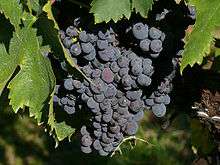Sagrantino
| Sagrantino | |
|---|---|
| Grape (Vitis) | |
 Sagrantino grapes | |
| Color of berry skin | Noir |
| Species | Vitis vinifera |
| Origin | Umbria, Italy |
| Notable regions | Perugia |
| Notable wines | Sagrantino di Montefalco DOCG, Montefalco Rosso DOC |
| VIVC number | 10457 |
Sagrantino is an Italian grape variety that is indigenous to the region of Umbria in Central Italy. It is grown primarily in the village of Montefalco and the surrounding area, with a recent rapid increase in planting area from 351 hectares (870 acres) in 2000 to 994 hectares (2,460 acres) by 2010[1] dedicated to the grape in the hands of about 50 producers.[2] With production still relatively limited, the wine is not widely known outside Italy, although it was granted DOCG status in 1992.[3]
The grape has one of the highest tannic levels of any variety in the world,[4] and creates wines that are inky purple with an almost-black center. The bouquet is one of dark, brooding red fruits with hints of plum, cinnamon, and earth. The Sagrantino di Montefalco DOCG requires the use of 100 percent Sagrantino grapes, with a minimum of 37 months' aging before release, 12 of which must be in oak barrels. Alcohol content is around 13 to 14 percent.
The origins of the grape are widely disputed, but what is known is that it was used primarily for dessert wines for many years, the grape being dried in the passito style, yielding a thick, syrupy wine with raisin and blueberry qualities, much like a Recioto di Valpolicella. Beginning in 1976, however, the wines were made in a dry style, and that is how they are primarily produced today.
Australia has now seen forms of this varietal from wineries such as Lou Miranda Estate, Coriole, Pizzini, Chalmers and Amadio Wines, all with varying styles of Sagrantino.
References
- ↑ Anderson, K and Aryal, NR (2013). Which Winegrape Varieties are Grown Where? A Global Empirical Picture. University of Adelaide Press. doi:10.20851/winegrapes. ISBN 978-1-922064-67-7.
- ↑ "Consortium Montefalco". Consortium Montefalco. Retrieved 24 July 2015.
- ↑ "Consortium Montefalco - Sagrantino, Umbria's Jewels". Consortium Montefalco. Retrieved 24 July 2015.
- ↑ Khan NQ, Patel B, Kang SS; et al. (20 May 2015). "Regulation of vascular endothelial function by red wine procyanidins: implications for cardiovascular health". Tetrahedron. 71 (20): 3059–3065. doi:10.1016/j.tet.2014.10.078.